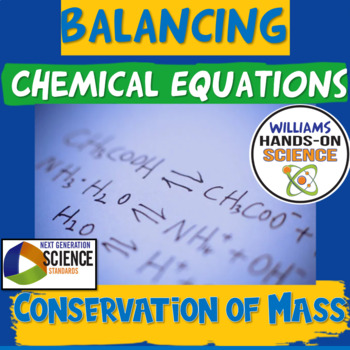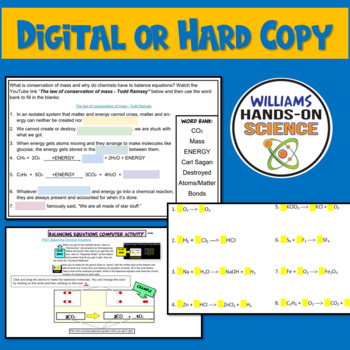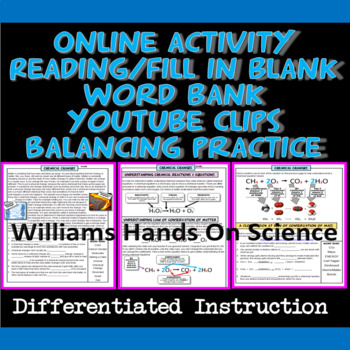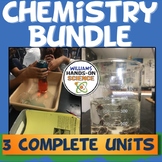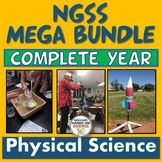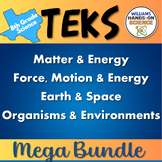Balancing Chemical Equations Reactions Conservation of Mass NGSS MS-PS1-5
- Zip
Also included in
- This NGSS bundle has everything you need for Structure and Properties of Matter (complete distance learning unit), PS1.B PS3.A Chemical Reactions Google Ready Bundle (complete distance learning unit) Chemical Reactions, Definitions of Energy, States of Matter, Periodic Table, Chemical Reactions, ConPrice $69.97Original Price $115.20Save $45.23
- This bundle is a time-saving, comprehensive and user-friendly complete year bundle for physical science Teachers that will streamline your teaching experience effortlessly! Every lesson is meticulously planned and just a click away. This extraordinary bundle is a treasure trove of engaging resourcesPrice $176.00Original Price $311.50Save $135.50
- The TEKS 8th Grade Bundle is a comprehensive resource for teaching science mainly in Texas, but it can be used in any state. This bundle includes over 60 hands-on, rigorous, engaging, and phenomena-driven lessons that cover the TEKS standards for 8th grade science. The lessons are designed to help sPrice $160.00Original Price $321.15Save $161.15
Description
This assignment is NO prep and it’s totally student centered. ALL of your students will be able to balance chemical equations after this activity!
This activity hits many learning styles to reach ALL OF YOUR STUDENTS! I use it to front load balancing chemical equations, however you can use it as a review OR FLIP THE CLASSROOM as well. You can make it completely student centered or facilitate the activity too. By the time the students are done with the activity they have a very good grasp of balancing chemical equations and understanding why we balance chemical equations by learning about the Law of Conservation of Matter. Students first read, or you can do a “read around”, they then watch “Chemical Changes: Crash Course Kids #19.2” on YouTube to understand the difference between chemical and physical changes. They do a fill in the blank using a word bank that goes along with the video clip. Then the students look at a diagram of how chemical equations are broken down with reactants, yields and products and what they all mean. Then the students go more in depth with balancing by watching “How to Balance Chemical Equations in 5 Easy Steps” with Wayne Breslyn on YouTube. After this, the students watch a TedEd video clip that discusses the basic principles of the Law of Conservation of Mass and why it’s so important. Again they do a fill in the blank using a word bank that goes along with the video. After this the students go to phet.colorado.edu and do a balancing equations game that really helps them practice in a meaningful way. The last page is 15 equations that the students attempt to balance. They start relatively easy and get progressively more difficult. This is where I assign some extra credit for the more difficult ones depending on my student’s abilities.
Try Distance Learning MS-PS1-5: Conservation of Mass Chemical Reactions as a scaffold or a reinforcement for this resource!
These concepts are included:
Chemical Change
Physical Change
Chemical Reaction
Evidence for chemical reactions
Molecules
Atoms
Chemical Bonds
Matter
Reactants
Products
Coefficients
Subscripts
The Law of Conservation of Mass/Matter
Balancing Chemical Equations
Or buy my bundle that includes all of CHEMISTRY products: ngss Chemistry Bundle
Elements, Atoms, Compounds and Molecules Card Sort
Flipping the Classroom Periodic Table Frayer Models
Physical Science Scaffolded Notes
Check out my bundle that includes all of my physics products NGSS Physics Resource Bundle
TERMS OF USE
• All rights reserved by Williams Hands On Science, Inc.
• This product is to be used by the original purchaser only.
• Intended for classroom and personal use only.
• Copying for more than one teacher, classroom, department, school, or school system is prohibited.
• This product may not be distributed or displayed digitally for public view.
• Failure to comply is a copyright infringement and a violation of the Digital Millennium Copyright Act (DMCA).
If there are any errors or questions, please contact me through TpT or email me at:
williamshandsonscience@gmail.com
Thank you for taking a look!
Please follow me on TpT for new products and check me out on Instagram for my products in action!

